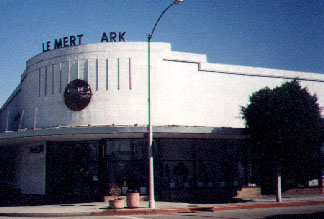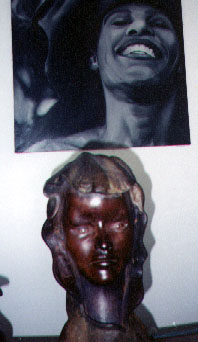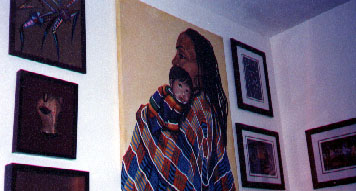Earl Underwood, interview notes
I donít know if itís because Blacks
here came from slavery or we got separated from family and all that- any
kind of sense of heritage and culture that Black folks havenít been able
to come together and work for the good of all as opposed to individually-you
know individual successes. That other cultures can come here and they stick
together and they thrive, because they stick together and theyíre not as
many people as we are-they may not be as educated as we are as a whole,
but they have one thing-they stick together! And they strive together for
the whole. And we donít have that sense -you know we havenít realized that
thatís our only salvation. Donít expect the White man to do it for you-they
are not going to do it for you. Youíve got to do it for yourself. If you
go into a community, a well to do community, or any community and look
at the different types of shops, specialty shops that are in that community,
the success is graded by just how much space is allotted for a gallery,
the preservation of that particular culture. So art is a pretty significant
factor, itís almost like a barometer as to how well that particular community
is doing,financially and morallyÖ
-
Earl Underwood, co-owner of The Leimert
Park Gallery and Leimert Park Business Center and local resident
In a recent article, Earl Underwood suggests that
now is the time for African-Americans to establish entrepreneurial business
in the Leimert Park. He reflects back to the "Black Wall Street" era and
place, in  what
is now Greenwood, Oklahoma, an African-American community prospered with
approximately 600 businesses occupied a 36 block area. In June of 1921
a race rioted was instigated by whites who brought on several days of rioting,
killing and destruction of most of the business. xii Underwood,
mirroring others in the community, believe Leimert Park is ripe for creating
a contemporary Black Wall Street within an atmosphere of relative safety,
shared cultural background and economic goals.
what
is now Greenwood, Oklahoma, an African-American community prospered with
approximately 600 businesses occupied a 36 block area. In June of 1921
a race rioted was instigated by whites who brought on several days of rioting,
killing and destruction of most of the business. xii Underwood,
mirroring others in the community, believe Leimert Park is ripe for creating
a contemporary Black Wall Street within an atmosphere of relative safety,
shared cultural background and economic goals.
At the age of 27 or 28 was the first time Earl
Underwood traveled outside of his home, Brooklyn, New York and visited
California. Need for a change and the laid back attitude found in California
were some of the deciding factors in Underwoodís transcontinental move.
His interests in the arts, however, remained with  him.
Underwood is a printer by trade. When he married, the couple began an art
mail order business at their home in the predominately white area of Burlingham,
California. A positive response from the initial 10,000 catalogues was
a promising sign for the emerging business. Soon came requests to come
and actually view the art presented in the catalogues, so gallery space
was needed. Something about Leimert Park Village kept pulling Earl Underwood
to it and here is where the gallery site was chosen.
him.
Underwood is a printer by trade. When he married, the couple began an art
mail order business at their home in the predominately white area of Burlingham,
California. A positive response from the initial 10,000 catalogues was
a promising sign for the emerging business. Soon came requests to come
and actually view the art presented in the catalogues, so gallery space
was needed. Something about Leimert Park Village kept pulling Earl Underwood
to it and here is where the gallery site was chosen.
I visited Leimert Park when I first got here. There was a high
concentration of Black owned businesses as well as a high concentration
of cultural channeling. So, I felt like I wanted to change locations and
get right into the community, and I started looking for vacancy in Leimert
Park, and finally wound up in this place here. xiv
The place in question is located on a corner at the
major intersection of the Village businesses in the enclave of Degnan Boulevard.
It is cavernous. The near floor to ceiling windows in which wrapped the
front of the structure allow one to view a spacious showroom where art,
ranging form prints, to original paintings, to sculptures and furniture
is show cased. The interior itself has been constructed in detail highlight
art in all visible aspects, from the lighting, curves of the walls and
images etched in the marble floor tiling. "The more attention you see given
to the arts; usually it indicates the more stable the community is. That
the people can appreciate their own community, are proud of being here,
and everything like that," xv Underwood believes.
This is belief is evident in the use of approximate
5000 square feet of space in which the Underwood business is located in.
At first glance, the multiple uses of this space are often hidden among
bright prints, framed originals and sandstone sculptures. There is also
a business center located here that "allows small and start businesses
an opportunity to get started in a safe adn supportive enviornment." xvi
The mission of the center is "to promote the arts in the black community,
create jobs and to help revitalize the Leimert PArk area so that it is
the thriving African-American business and cultural center that it should
be." xxvii One example of this is a partnership with Roloflez Sports
Industries, Inc. an "in-line skating manufacturer with patented technology
able to revolutionize the entire inline skating industry." This technology
will create a variety of jobs and opportunities in our community." xviii
Aside from being a gallery and buisiness center, community-oriented
events occur here also, including free weekly childrenís art classes, sculpture
classes, and Sunday jazz nights. The office of the Leimert Park Village
Community Development Corporation (LPVCDC) and accompanying publication,
The Village Drum, which Earl Underwood serves as a member of the Directorís
Board, currently resides here also. More will discussed about the LPVCDC
later.
Underwood contributes a significant portion of
the Afro-centric cultural presence felt in Leimert Park today to the efforts
of Dale and Alonzo Davis, the co-owners of the now defunct Brockman Gallery.
I think the real cultural push in the 60ís
was Dale and Alanzo Davis, they opened up the Brockman Gallery. I think
at that point it was known as an artistic cultural community. And, its
been going up and down for a number of years. I think when Dan and Alanzo
first started, theyíd seen businesses-actually all things that have worked
out of their shops and itís kinda changed to a more commercialized aspect.
And also that change is probably the most obvious change, the more commercial,
cultural business has taken over response of the artist. Prior to the civil
disturbances thereís been a lot more activity down here. You know, civil
disturbance kinda messed up things for the entire L.A. area not just Leimert
Park. xix
Founded in 1967, the gallery served as the
center point for blossoming enterprises and an artistic haven for African-Americans.
Although now defunct, former co-owner Alanzo Davis states that the gallery
provided a needed outlet within L.A.ís African-American community after
the 1965 civil disturbance. "After the Watts riot there were a lot of artists
doing works that were politically significant. They were  making
statements that were social. We filled a gap and a void there. We just
opened up a window that had never been available, especially on the West
Coast, " suggests Alonzo Davis.xx The Brockman Gallery cradled the early
careers of now such notable African-American artists as sculptor and printmaker
Elizabeth Catlett and painter and muralist John Biggers.xxi
making
statements that were social. We filled a gap and a void there. We just
opened up a window that had never been available, especially on the West
Coast, " suggests Alonzo Davis.xx The Brockman Gallery cradled the early
careers of now such notable African-American artists as sculptor and printmaker
Elizabeth Catlett and painter and muralist John Biggers.xxi
As I was speaking with Earl Underwood in the Leimert
Park Gallery, our interview was interrupted constantly. The intruders were
not necessarily customers, but future artists in training who were neighborhood
children coming to begin their weekly art class.
home | unedited interview
 him.
Underwood is a printer by trade. When he married, the couple began an art
mail order business at their home in the predominately white area of Burlingham,
California. A positive response from the initial 10,000 catalogues was
a promising sign for the emerging business. Soon came requests to come
and actually view the art presented in the catalogues, so gallery space
was needed. Something about Leimert Park Village kept pulling Earl Underwood
to it and here is where the gallery site was chosen.
him.
Underwood is a printer by trade. When he married, the couple began an art
mail order business at their home in the predominately white area of Burlingham,
California. A positive response from the initial 10,000 catalogues was
a promising sign for the emerging business. Soon came requests to come
and actually view the art presented in the catalogues, so gallery space
was needed. Something about Leimert Park Village kept pulling Earl Underwood
to it and here is where the gallery site was chosen.
 what
is now Greenwood, Oklahoma, an African-American community prospered with
approximately 600 businesses occupied a 36 block area. In June of 1921
a race rioted was instigated by whites who brought on several days of rioting,
killing and destruction of most of the business. xii Underwood,
mirroring others in the community, believe Leimert Park is ripe for creating
a contemporary Black Wall Street within an atmosphere of relative safety,
shared cultural background and economic goals.
what
is now Greenwood, Oklahoma, an African-American community prospered with
approximately 600 businesses occupied a 36 block area. In June of 1921
a race rioted was instigated by whites who brought on several days of rioting,
killing and destruction of most of the business. xii Underwood,
mirroring others in the community, believe Leimert Park is ripe for creating
a contemporary Black Wall Street within an atmosphere of relative safety,
shared cultural background and economic goals.
 making
statements that were social. We filled a gap and a void there. We just
opened up a window that had never been available, especially on the West
Coast, " suggests Alonzo Davis.xx The Brockman Gallery cradled the early
careers of now such notable African-American artists as sculptor and printmaker
Elizabeth Catlett and painter and muralist John Biggers.xxi
making
statements that were social. We filled a gap and a void there. We just
opened up a window that had never been available, especially on the West
Coast, " suggests Alonzo Davis.xx The Brockman Gallery cradled the early
careers of now such notable African-American artists as sculptor and printmaker
Elizabeth Catlett and painter and muralist John Biggers.xxi